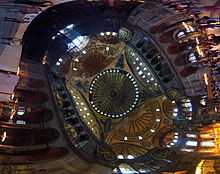Anthemius of Tralles
Anthemius of Tralles (c. 474 – before 558; Ancient Greek: Ἀνθέμιος ὁ Τραλλιανός) was a Greek professor of Geometry in Constantinople and architect, who collaborated with Isidore of Miletus to build the church of Hagia Sophia by the order of Justinian I. Anthemius came from an educated family, one of five sons of Stephanus of Tralles, a physician. Of his brothers, Dioscorus followed his father's profession in Tralles; Alexander became at Rome one of the most celebrated medical men of his time; Olympius was deeply versed in Roman jurisprudence; and Metrodorus was a distinguished grammarian in Constantinople.
As an architect he is best known for replacing the old church of Hagia Sophia at Constantinople in 532; his daring plans for the church strikingly displayed his knowledge. His skills seem also to have extended to engineering for he repaired the flood defences at Daras.

Anthemius was also a capable mathematician. He described the string construction of the ellipse[1] and he wrote a book on conic sections, which was excellent preparation for designing the elaborate vaulting of Hagia Sophia. He compiled a survey of mirror configurations in his work on remarkable mechanical devices which was known to Arab mathematicians such as Ibn al-Haytham.
A fragment of his treatise On burning-glasses was published as Περί παραδόξων μηχανημάτων ("Concerning wondrous machines") by L. Dupuy in 1777, and also appeared in 1786 in the forty-second volume of the Histoire de l'Academie des Instrumentistes. A. Westermann gave a revised edition of it in his Παραδοξογράφοι (Scriptores rerum mirabilium Graeci, "Greek marvel-writers") in 1839. In the course of the constructions for surfaces to reflect to one and the same point
- all rays in whatever direction passing through another point,
- a set of parallel rays,
Anthemius assumes a property of an ellipse not found in Apollonius's work, that the equality of the angles subtended at a focus by two tangents drawn from a point, and having given the focus and a double ordinate he goes on to use the focus and directrix to obtain any number of points on a parabola—the first instance on record of the practical use of the directrix.
Citations and footnotes
- ↑ Boyer (1991). "Revival and Decline of Greek Mathematics". p. 193.
The commentary by Eutocius on the Conics of Apollonius was dedicated to Anthemius of Tralles (t534), an able mathematician and architect of St. Sophia of Constantinople, who described the string construction of the ellipse and wrote a work On Burning-mirrors in which the focal properties of the parabola are described.
Missing or empty|title=(help)
Although Anthemius died not 534 but before 558, cf. Oxford Dictionary of Byzantium, p. 109.
References
- Procopius, De Aedific. i. 1
- Agathias, Hist. v. 6–9
- Edward Gibbon's Decline and Fall, cap. xl.
-
 This article incorporates text from a publication now in the public domain: Chisholm, Hugh, ed. (1911). "Arthemius". Encyclopædia Britannica (11th ed.). Cambridge University Press.
This article incorporates text from a publication now in the public domain: Chisholm, Hugh, ed. (1911). "Arthemius". Encyclopædia Britannica (11th ed.). Cambridge University Press. - Huxley, G.L. (1970). "Anthemius of Tralles". Dictionary of Scientific Biography 1. New York: Charles Scribner's Sons. pp. 169–170. ISBN 0-684-10114-9.
- T. L. Heath, A History of Greek Mathematics (2 Vols.) (Oxford, 1921)
- G. L. Huxley, Anthemius of Tralles (Cambridge, Mass., 1959).
- Boyer, Carl B. (1991). A History of Mathematics (Second ed.). John Wiley & Sons, Inc. ISBN 0-471-54397-7.
External Links
- "Anthemius of Tralles." Complete Dictionary of Scientific Biography. 2008. Retrieved January 18, 2015 from Encyclopedia.com:
- O'Connor, John J.; Robertson, Edmund F., "Anthemius of Tralles", MacTutor History of Mathematics archive, University of St Andrews.